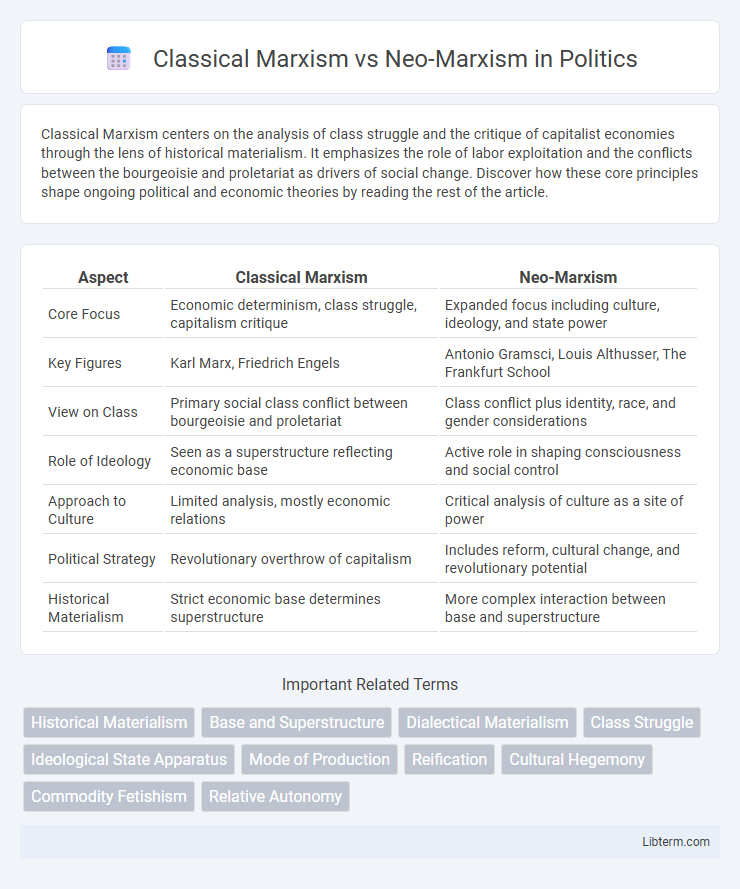Classical Marxism centers on the analysis of class struggle and the critique of capitalist economies through the lens of historical materialism. It emphasizes the role of labor exploitation and the conflicts between the bourgeoisie and proletariat as drivers of social change. Discover how these core principles shape ongoing political and economic theories by reading the rest of the article.
Table of Comparison
| Aspect | Classical Marxism | Neo-Marxism |
|---|---|---|
| Core Focus | Economic determinism, class struggle, capitalism critique | Expanded focus including culture, ideology, and state power |
| Key Figures | Karl Marx, Friedrich Engels | Antonio Gramsci, Louis Althusser, The Frankfurt School |
| View on Class | Primary social class conflict between bourgeoisie and proletariat | Class conflict plus identity, race, and gender considerations |
| Role of Ideology | Seen as a superstructure reflecting economic base | Active role in shaping consciousness and social control |
| Approach to Culture | Limited analysis, mostly economic relations | Critical analysis of culture as a site of power |
| Political Strategy | Revolutionary overthrow of capitalism | Includes reform, cultural change, and revolutionary potential |
| Historical Materialism | Strict economic base determines superstructure | More complex interaction between base and superstructure |
Introduction to Classical Marxism and Neo-Marxism
Classical Marxism, rooted in the works of Karl Marx and Friedrich Engels, focuses on the critique of capitalism, historical materialism, and the class struggle between the bourgeoisie and proletariat. Neo-Marxism expands on these foundations by integrating contemporary social theories, addressing cultural and ideological factors alongside economic structures. Both frameworks analyze societal inequality but differ in their emphasis on economic determinism versus cultural and ideological influences.
Historical Origins of Classical Marxism
Classical Marxism originated in the mid-19th century through the works of Karl Marx and Friedrich Engels, emphasizing the materialist conception of history and class struggle as the driving forces of societal change. It centers on the critique of capitalism, highlighting the exploitation of the proletariat by the bourgeoisie within the capitalist mode of production. This foundational theory laid the groundwork for later adaptations such as Neo-Marxism, which incorporates elements of culture, ideology, and superstructure beyond the original economic determinism.
The Emergence of Neo-Marxism
The emergence of Neo-Marxism marked a significant evolution from Classical Marxism by integrating broader social, cultural, and ideological dimensions into the analysis of capitalism and class struggle. Influential thinkers such as Antonio Gramsci introduced the concept of cultural hegemony, emphasizing how dominant groups maintain power through ideological control rather than solely through economic means. This theoretical expansion allowed Neo-Marxism to address complexities in modern capitalist societies that Classical Marxism, rooted primarily in economic determinism, struggled to fully explain.
Core Philosophical Differences
Classical Marxism centers on the labor theory of value, historical materialism, and the inevitability of proletarian revolution driven by class struggle. Neo-Marxism expands this framework by integrating cultural, ideological, and psychological factors, emphasizing the role of superstructures and modern capitalist complexities. While Classical Marxism focuses on economic determinism, Neo-Marxism highlights the multifaceted nature of social power and the significance of culture and ideology in maintaining capitalist dominance.
Views on Class Struggle and Social Change
Classical Marxism views class struggle as the primary engine of social change, emphasizing the conflict between the bourgeoisie and proletariat as leading to revolutionary overthrow of capitalism. Neo-Marxism expands on this by incorporating cultural, ideological, and institutional factors, recognizing multiple dimensions of oppression beyond purely economic class conflict. It also considers the role of race, gender, and social movements in transforming society, moving beyond the economic determinism of classical theory.
The Role of the State: Classical vs. Neo-Marxist Perspectives
Classical Marxism views the state as an instrument of class oppression, primarily serving the interests of the bourgeoisie to maintain capitalist dominance. Neo-Marxism expands this perspective by recognizing the state's relative autonomy, suggesting it can mediate class conflicts and implement reforms without fully dismantling capitalist structures. This evolution highlights debates on state intervention, ideological control, and the possibility of progressive change within advanced capitalist societies.
Approaches to Ideology and Culture
Classical Marxism views ideology as a reflection of the economic base, emphasizing the role of material conditions and class struggle in shaping social consciousness. Neo-Marxism expands this perspective by incorporating cultural and ideological superstructures as relatively autonomous forces that actively influence social dynamics and power relations. This approach highlights the significance of culture, media, and ideology in maintaining hegemony and social control beyond purely economic factors.
Critiques of Capitalism: Comparing Frameworks
Classical Marxism critiques capitalism by emphasizing the inherent exploitation of labor, surplus value extraction, and class struggle between bourgeoisie and proletariat as the engine of societal change. Neo-Marxism expands this framework by integrating cultural, ideological, and institutional dimensions, analyzing capitalism's adaptability through mechanisms like consumer culture and media influence to sustain hegemony. Both frameworks target the systemic inequalities and alienation produced by capitalist modes of production but differ in scope and interdisciplinary approaches to critique contemporary capitalism.
Influence on Contemporary Social Movements
Classical Marxism, rooted in the analysis of class struggle and economic exploitation, profoundly influenced early labor unions and socialist movements seeking proletarian revolution. Neo-Marxism expands this framework by integrating cultural, racial, and gender critiques, shaping contemporary social movements such as Black Lives Matter and feminist activism. Both ideologies emphasize systemic change, but Neo-Marxism's broader analytical lens addresses intersectionality within social justice campaigns.
Conclusion: Relevance in the Modern World
Classical Marxism provides foundational insights into class struggle and capitalist exploitation, but its economic determinism and rigid class focus limit its applicability to today's diverse social realities. Neo-Marxism expands on these principles by integrating cultural, ideological, and institutional factors, offering a more nuanced analysis relevant to contemporary issues like identity politics and global capitalism. This evolution ensures that Marxist theory remains a vital framework for critiquing power structures and addressing socio-economic inequalities in the modern world.
Classical Marxism Infographic

 libterm.com
libterm.com